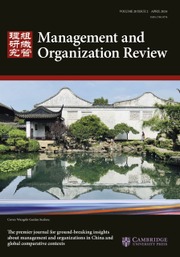No CrossRef data available.
Article contents
Partner Repeatedness and Alliance Reconfiguration
Published online by Cambridge University Press: 04 August 2025
Abstract
This study examines how partner repeatedness drives alliance reconfiguration. Using data on 571 fund products initiated by 58 Chinese fund firms from 2007 to 2011, our results indicate that higher levels of partner repeatedness drive firms to reconfigure their alliance by re-introducing previous partners (those that have collaborated with the focal firm in the past, but not currently), rather than dropping active partners or introducing new ones, in an attempt to retain the positive aspects and mitigate the negative effects of partner repeatedness. However, resource richness and firms' centrality in their industries play a key moderating role, as these factors affect the perceived efficacy of the reconfiguration strategies at firms' disposal.
摘要
本研究探讨了合作伙伴重复度如何推动联盟重组。基于 2007 年至 2011 年间 58 家中国基金公司发起的 571 只基金产品的数据,我们的研究结果表明,较高的合作伙伴重复度促使企业通过重新引入曾与其合作过的旧伙伴(即曾与核心企业合作但当前不再合作的伙伴), 而非终止现有的活跃伙伴关系或引入新伙伴,来重组联盟。这种做法旨在保留合作伙伴重复性的积极方面,同时缓解其负面影响。然而,伙伴资源的丰富度及企业在行业中的中心性起到了关键的调节作用,因为这些因素影响了企业可用重组策略的感知有效性。
Keywords
Information
- Type
- Article
- Information
- Copyright
- Copyright © The Author(s), 2025. Published by Cambridge University Press on behalf of International Association for Chinese Management Research

